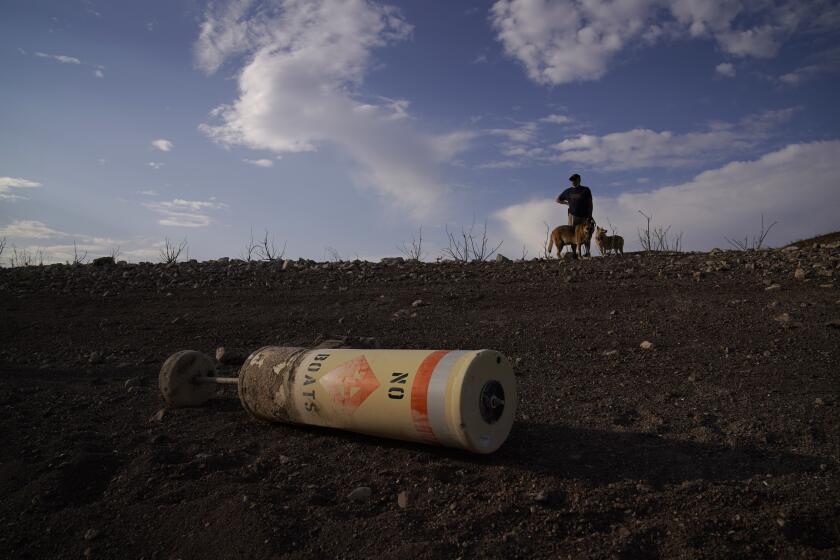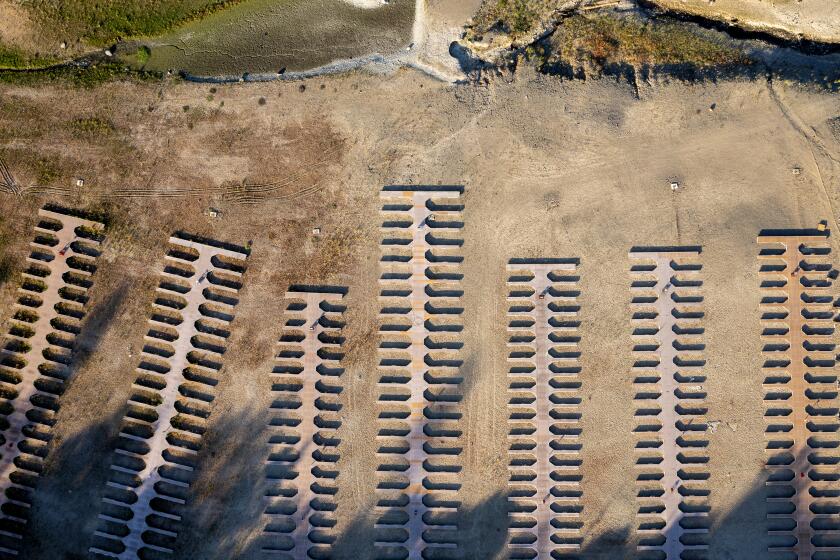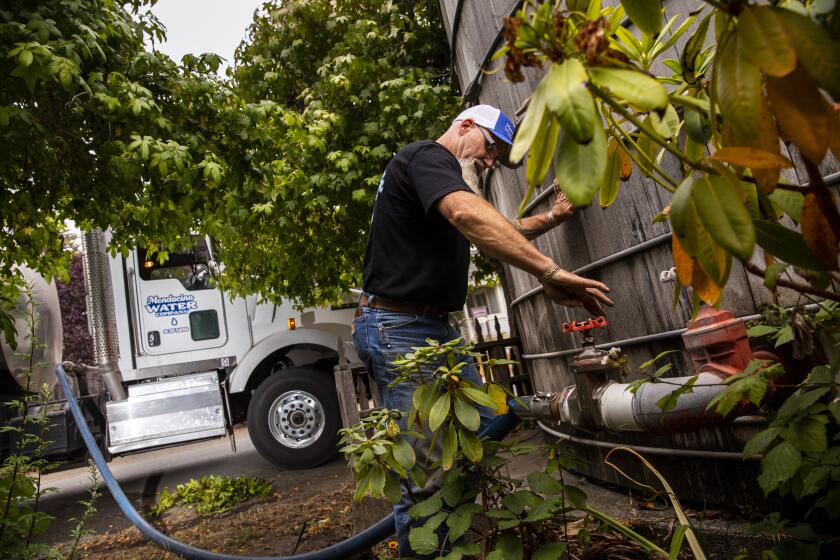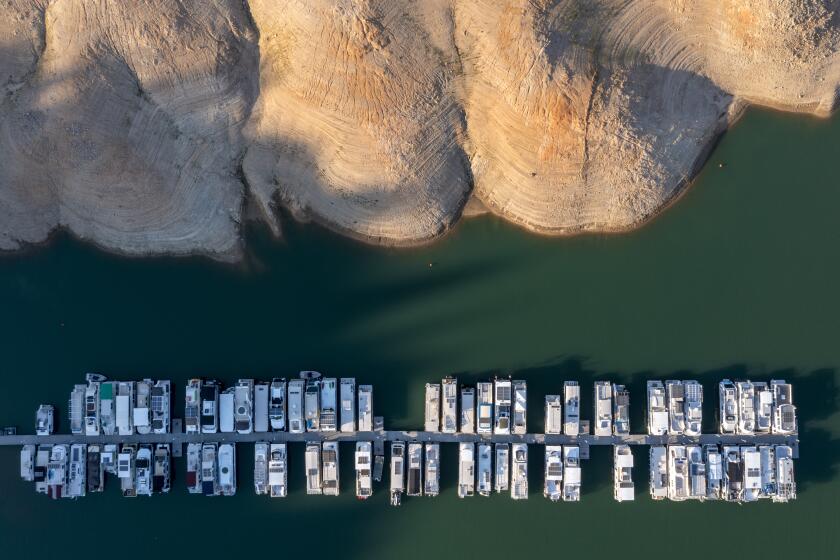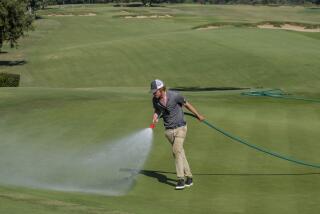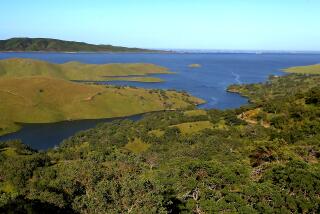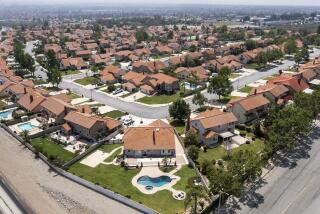Southern California water officials declare supply alert amid worsening drought
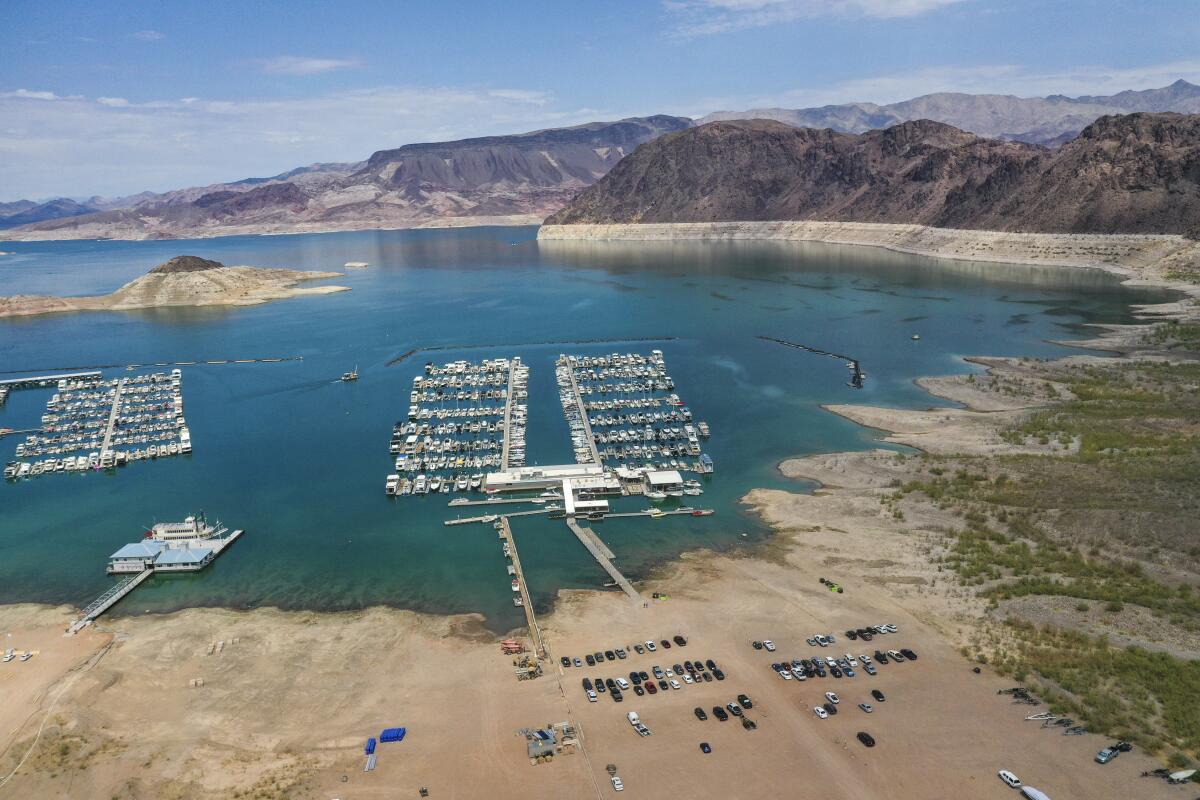
- Share via
Southern California’s powerful water agency on Tuesday issued a supply alert, calling on the region to conserve vital resources and prepare for continued drought — a move that brings the state’s largest population center closer to the tough water restrictions imposed on communities elsewhere.
The move comes one day after U.S. officials declared the first-ever water shortage on the Colorado River, which is a key source of water for the region.
The Metropolitan Water District of Southern California supplies water to some 19 million people across six counties and is one of the largest water distributors in the nation. The decision by its board Tuesday marks the first time in seven years that the agency has issued an official supply alert — the third of four escalating phases in its water supply framework.
The declaration calls on residents to voluntarily reduce their water consumption in order to preserve the region’s storage reserves. It is also intended to help mitigate the need for more severe actions in the future, which could include restricting water supplies to MWD’s 26 member agencies.
U.S. officials declared the first-ever water shortage for the Colorado River that serves 40 million people in the West.
“This is a wake-up call for what lies ahead. This is climate change,” MWD Chief Operating Officer Deven Upadhyay said during a news conference about the declaration. “This water supply alert sounds the start of a unified message across our region.”
In July, Gov. Gavin Newsom called on all Californians to voluntarily cut back water use by 15%. Fifty of the state’s 58 counties are now under a state of drought emergency, mostly in Central and Northern California.
Officials had hoped Southern California would not see such drastic action, with the MWD reassuring residents that the region has enough supply in reserves for the year. But after a winter of critically low precipitation — as well as the rapid loss of snowpack due to fire, drought and climate change — reservoirs across the West are shrinking at a worrisome clip, and concerns about dwindling supplies are mounting.
“We cannot overstate the seriousness of this drought,” Upadhyay said. “Conditions are getting worse, and more importantly, we don’t know how long it will last.”
California resorts to unprecedented water cutoffs as drought worsens. How bad is it?
Reservoir levels for both the Colorado River and State Water Project — which provide the MWD with roughly half its water — are reaching historically low levels, officials said. In recent months, the largest reservoir on the Colorado River, Lake Mead, has tipped into crisis.
Water levels in Lake Mead on Tuesday hovered at 1,068 feet, about 35% of capacity, according to the U.S. Bureau of Reclamation. The reservoir is considered a water lifeline for about 25 million people in the West.
MWD General Manager Adel Hagekhalil said the federal decision to declare a Colorado River shortage was an indication that a stronger response is needed amid the ongoing drought.
“The Colorado River is sending us a clear message: conserve, reuse and recycle,” Hagekhalil said in a statement. “This shortage announcement moves the river into a new era and reinforces the need for Southern Californians to use less water to preserve this critical supply.”
While the shortages in the Colorado River spell deep trouble for the future, MWD’s priority rights mean that their water supply from the river won’t be affected in the immediate future.
“California is not going to be impacted next year at all. But maybe in 2023 and more likely in 2024, if the drought continues,” said Bill Hasencamp, manager of Colorado River Resources for the Metropolitan Water District.
The MWD’s other imported water source, the State Water Project, is of more immediate concern.
The 705-mile storage and delivery system collects water from rivers and tributaries and redistributes it throughout the state. One of its largest reservoirs, Lake Oroville, has seen such a precipitous drop in its water level that state officials had to take its major hydroelectric power plant offline for the very first time.
The State Water Project has already reduced MWD’s water allocation to 5%, officials said. Next year, that allocation could be reduced to zero.
“We should be concerned about that,” MWD spokeswoman Rebecca Kimitch said of the possibility. “It is another indication of just how severe these drought conditions are. Even when the rains return, it will be harder to build back our reserves because our mountains are so dry. Everything we do now to save water will help us get through a low State Water Project allocation next year.”
Lake Oroville, Folsom Lake and Trinity Lake provide a glimpse into the state’s dry spell.
Many who study water resources and drought said the actions this week were inevitable.
“This is absolutely not a surprise,” said Glen MacDonald, a UCLA distinguished professor of California and the American West. “In some ways, it’s a credit to the Bureau of Reclamation that they managed the reservoir system on the Colorado so well to avoid this up to now. But honestly, it’s unavoidable.”
Due to an historic miscalculation of average river flow, as well as the massive growth of urban areas it supplies, the Colorado River is oversubscribed even in the best of times.
To complicate matters, MacDonald said, the Colorado River Basin has proven to be even more vulnerable to climate change than scientists previously thought. Evaporation rates are highly sensitive to rising temperatures, he said, and even if precipitation were to return, it would likely not be enough to keep up with the loss of water.
This is concerning for Californians — who are once again confronting the potential for restrictions and dead, brown lawns — but even more so for the nation’s food supply, which is highly dependent on the state’s farmlands for its provisions, MacDonald said.
Already, farmers are having to fallow fields and grapple with significant water shortages. State water regulators this month issued an emergency order barring thousands of farmers from using stream and river water.
MacDonald said the “perfect drought”— like a “perfect storm” — is one in which both the Colorado River Basin and California’s internal water supplies are affected.
“We are living in the perfect drought, right now,” he said. “It’s unfortunate, but we kind of have seen this coming.”
Communities along the Mendocino County coast are heavily reliant on tourists — and on rapidly drying wells for their water.
MWD officials on Tuesday said they were too far removed from individual consumers to say whether residents responded to Newsom’s July call for voluntary conservation, but noted that their deliveries throughout the summertime were moderate — a good sign.
But some community members are asking the board to do even more.
“We should be planning for the driest day,” said one caller, Conner Everts of the Southern California Watershed Alliance, during the board meeting. “Until you do mandatory conservation and take that step forward, we’re not going to see the results we’ve seen in the past. And we need them now more than ever.”
Should the MWD move into the fourth and final level of its framework — water supply allocation — the agency still could not impose restrictions on customers, officials said.
Under an allocation, the MWD sets reduced amounts of water that will be provided to its 26 member agencies and implements higher rates for increased use. Officials encouraged member agencies to adopt measures tailored to their own local conditions, such as increasing outdoor water use restrictions, prohibiting home car-washing and requiring restaurants to only serve water upon request.
Some member agencies have already taken such steps, such as the city of Glendale, which last week approved an ordinance limiting outdoor watering to three days a week and implemented an additional drought charge on residents.
Other cities, like Los Angeles and Pasadena, never lifted watering day restrictions from previous dry years.
While droughts are common in California, this year’s is much hotter and drier than others, evaporating water more quickly from the reservoirs
The MWD last issued a water supply alert in 2014, before moving into an even more restrictive phase in 2015, officials said. It was reduced to lower phases amid the wetter years of 2016 and 2017.
Demetri Polyzos, the agency’s water resource planning manager, compared the tiered system to the water district’s version of the DEFCON system used by the U.S. military.
The baseline tier is water use efficiency, followed by a water supply watch — which allows for the use of regional storage reserves — then a water supply alert, which allows for broader measures.
“The final tier, which we avoid at all costs, is going into an allocation,” Polyzos explained.
More to Read
Sign up for Essential California
The most important California stories and recommendations in your inbox every morning.
You may occasionally receive promotional content from the Los Angeles Times.
